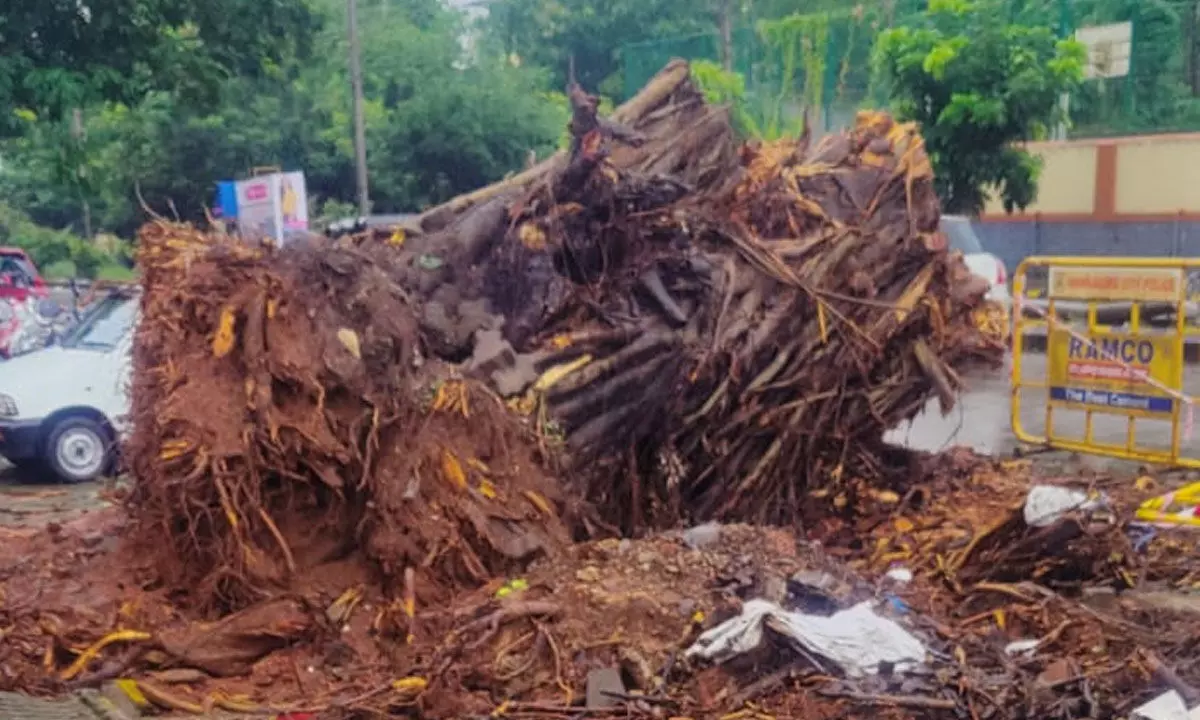Live
- They always want me to win, and now I feel lucky to have been offered a story like ‘Zebra’: Satyadev Kancharana
- ‘Democracy first, humanity first’: PM Modi in Guyana's parliament on two countries' similarities
- PKL Season 11: Telugu Titans register third straight win to top standings
- Is Pollution Contributing to Your COPD?
- NASA Unveils Underwater Robots for Exploring Jupiter's Moons
- Additional Central forces arrive in violence-hit Manipur
- AR Rahman and Saira Banu’s Divorce: Legal Insights into Common Issues in Bollywood Marriages
- 82.7 pc work completed in HPCL Rajasthan Refinery area: official
- Curfew relaxation extended in 5 Manipur districts on Friday
- Tab scam prompts Bengal govt to adopt caution over fund disbursement
Just In
Urban spaces greening A model gone wrong?


There are only a few cries being raised against massive deforestation for the taking infrastructure corridors across the length and breadth of the country- Railways, Highways, power transmission lines, river garlanding, inter-basin river water transfer and widening of highways and Petroleum and oil pipeline corridors.
Mangaluru: There are only a few cries being raised against massive deforestation for the taking infrastructure corridors across the length and breadth of the country- Railways, Highways, power transmission lines, river garlanding, inter-basin river water transfer and widening of highways and Petroleum and oil pipeline corridors. This eco-sensitive region abounds by western ghats and the Arabian Sea has seen it all.
But closer to the cities outside and within, the social greening programmes have all gone wrong, this is not a fleeting statement that the urban environmentalists make, but the urban tree plantation programmes is definitely suffering on many counts, due to which the survival rate of urban tree plantations has dwindled to just 60 per cent all around the state while on the coastal districts, the survival rate is slightly better at 75 per cent.
The green activists point out at three basic reasons why the urban afforestation programme does not yield the expected results firstly there are no spaces for afforestation, -the proverbial ‘ trees on both sides of the roads’ failed totally or are just not on the plans of the town planners. The green activist say many times the greens dig by the road margins but only to find there is a drain underneath and there is no space available to plant a sapling. Secondly, the saplings chosen for planting in urban areas are generally exotic that do not survive long enough and grow to their full growth. And Thirdly “the trees are not given adequate space at the bottom to absorb rainwater or even the water fed by the municipalities, in the melee of keeping every inch of the road covered with bituminous tarmac or concrete or the tightly packed interlock pavements the trees die a slow death says Shashidhar Shetty the district convenor of National Environmental Conservation Federation (NECF).
The recent fall of a big banyan tree at a place called Lady Hill in Mangaluru city has made headlines “This unfortunate debacle of a tree has a lesson for all of us to learn, especially the municipal administrators, the mindless trimming of the aerial roots had imbalanced the tree and let to tilting on one side. In addition, while making the road and the pavements they had tightly packed the space around the stem at the road level which has strangulated the tree and prevented water percolation to the roots” Shashidhar says.
It is felt that Mangalore city was fast losing its green cover and at some time during last year the figures with the district office had shown that the area under green cover in the city had dropped down to a mere 17 per cent which was far below the healthy level of 33 per cent. This fact development was attributed to the rapid denudation of green social forests in the city for making way for wider roads, multi-storey buildings, commercial complexes and public amenities. Greenery however was restricted to a few pockets in parks.
Three top botanists of the country Gopalakrishna Bhat, late B.V. Shetty and late K.M. Kaveriappa (who is also the Vice Chancellor of Mangalore University) in their book `Plant Resources of Western Ghats and Low lands of Dakshina Kannada and Udupi’ mentions that there are 75 species of trees that are endemic to western ghats, they also grow well in the coastal low lands. The book enumerates the qualities of these threes in great detail and several of them including Vateria indica (Dhoopada mara) Polyalthia fragrans (Gowri Mara) Pinaga dicksonii (Palme) Hopea Ponga ( Doddele bogi) Largestromia microcarpa (Bili Nandi) and many others can grow well in the coastal low lands too.
Mr. Vijaya Kumar says the forest department has identified some of the most commonly found tree species in the western ghats that includes Honge, Mahagony, Jack and wild jack, Holae Dasavala, Matti and Ramapatre which are suitable for growing in the city. He said wherever possible the department also wants to introduce Bamboo as ornamental species in the city area.
However, the new generation of green warriors of the coast under the watchful eyes of the NECF have taken up the tree plantation on a scientific basis and their knowledge about each tree and its usefulness to nature is impressive. Every Sunday they take up a particular stretch on the Highway for their greening projects, smartly aided by the NHAI and the Forest Department. A high-thinking philanthropist, Rohan Michael Shiri gives them support for their projects.

© 2024 Hyderabad Media House Limited/The Hans India. All rights reserved. Powered by hocalwire.com






